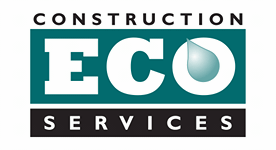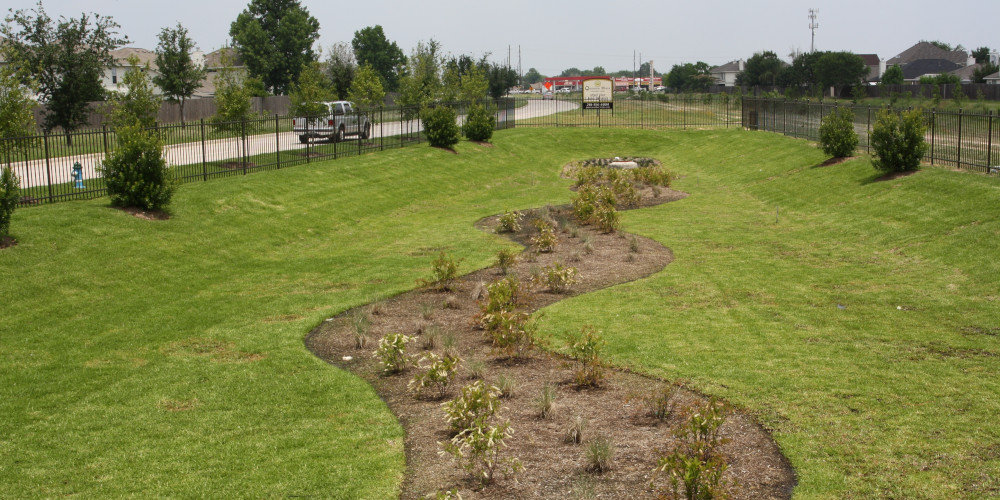
CASE STUDY: Queenston Manor
Low Impact Development Methods Save the Day
SUMMARY
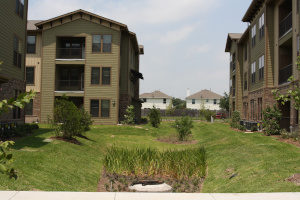 Queenston Manor Apartments sits on a 7.2-acre parcel of land located adjacent to a master planned community on Houston’s northwest side. When Academy Development originally planned the construction of the apartment complex, the economic model required that nine apartment buildings be built to generate the required revenue stream. Further, all their detention requirements would be accounted for offsite in a surrounding master planned development. This turned out not to be the case.
Queenston Manor Apartments sits on a 7.2-acre parcel of land located adjacent to a master planned community on Houston’s northwest side. When Academy Development originally planned the construction of the apartment complex, the economic model required that nine apartment buildings be built to generate the required revenue stream. Further, all their detention requirements would be accounted for offsite in a surrounding master planned development. This turned out not to be the case.
SITUATION
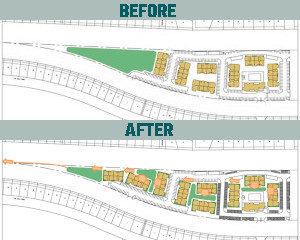 The project came to a screeching halt when it was determined by the County that the volume presumably set aside was no longer available for use by the apartment site. Faced with the harsh reality that this project might no longer be viable due to the amount of site area which would otherwise be lost to a detention pond, a solution was in need that would require a new way of thinking. The requirements for the solution were:
The project came to a screeching halt when it was determined by the County that the volume presumably set aside was no longer available for use by the apartment site. Faced with the harsh reality that this project might no longer be viable due to the amount of site area which would otherwise be lost to a detention pond, a solution was in need that would require a new way of thinking. The requirements for the solution were:
- Recapture buildable space otherwise used for a large detention pond
- Reliability was key, as all stormwater drainage areas doubled as common areas and courtyards
- 24-hours after of a rain event, the system needed to drain leaving no standing water
How did a new, LID-based appraoch help save the day?
SOLUTION
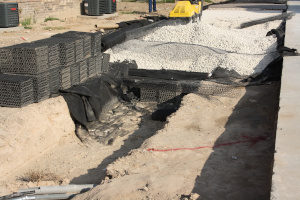 Working with Construction EcoServices, the engineers at EHRA, Inc. rescued this project using Low Impact Development (LID). The objective was to reduce peak flows and thereby decrease total detention volume under Harris County’s LID Design Guide which requires post and pre-development hydrography matching. Doing so would allow the developer to recapture the real estate that would have otherwise been occupied by a detention facility in the traditional design. Recapturing this real estate made the site viable for apartment construction once again. The LID solution included porous pavers in parking stalls, as well as vegetated depressions and swales using the FocalPoint High Performance Modular Bio‑filtration System (HPMBS).
Working with Construction EcoServices, the engineers at EHRA, Inc. rescued this project using Low Impact Development (LID). The objective was to reduce peak flows and thereby decrease total detention volume under Harris County’s LID Design Guide which requires post and pre-development hydrography matching. Doing so would allow the developer to recapture the real estate that would have otherwise been occupied by a detention facility in the traditional design. Recapturing this real estate made the site viable for apartment construction once again. The LID solution included porous pavers in parking stalls, as well as vegetated depressions and swales using the FocalPoint High Performance Modular Bio‑filtration System (HPMBS).
RESULTS
 The design team was able to decrease the surface storage volume requirements for the property enough to not only save the project, but the development company was able to build two additional apartment buildings. For the developers, the 48 additional apartment units meant the difference between success and a cancelled project, as well as increased long-term revenue and higher property value.
The design team was able to decrease the surface storage volume requirements for the property enough to not only save the project, but the development company was able to build two additional apartment buildings. For the developers, the 48 additional apartment units meant the difference between success and a cancelled project, as well as increased long-term revenue and higher property value.
